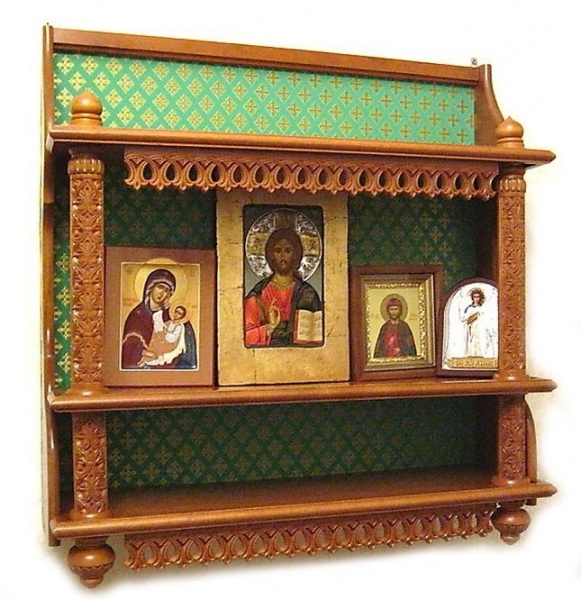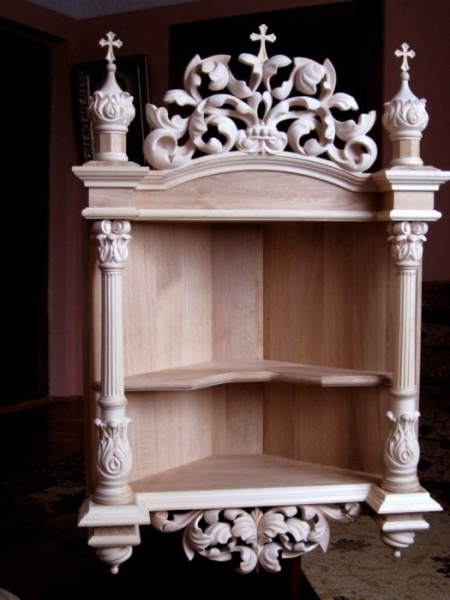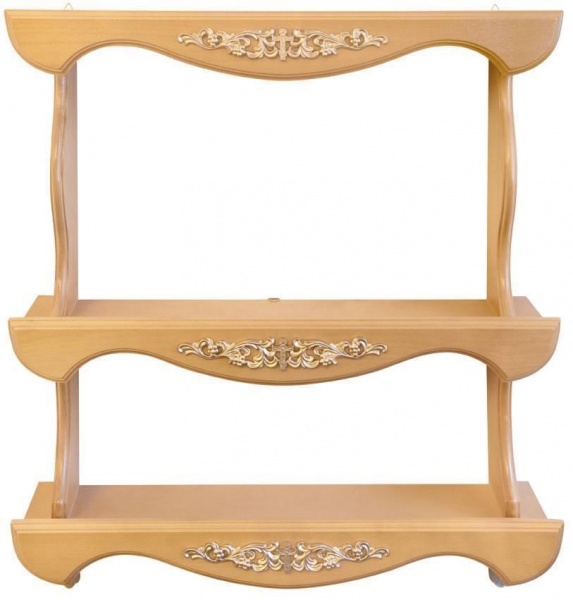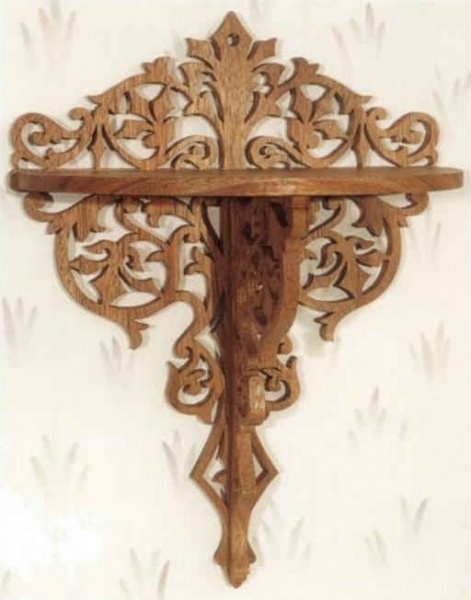Do-it-yourself shelves for icons
Following the Orthodox traditions of the Slavs, many decorate their living space with icons. This reflects the desire of believers to show respect for the church and become closer to religion. Since ancient times, the icons in the house were located on the iconostasis, which is called the goddess or the red corner. Now the icons are hung directly on the wall or mounted on a shelf that plays the role of an iconostasis. The desire to equip a sacred place in a special way leads to the decision to make a shelf for icons on your own.
Design Options
Orthodox canons suggest placing icons on the eastern wall. Alternatively, the place of the iconostasis is arranged in a corner directed to the east. Depending on the selected area, the shelf can be straight or angular. The small dimensions of the corner shelf require the arrangement of a multi-tiered structure. The shelf can be equipped with a back wall. Often it is decorated with carvings depicting birds, vegetation or the outlines of the holy apostles. The traditions of Orthodoxy do not provide for the placement of items that are not related to religion next to church paraphernalia. Having decided on the shape of the shelf, they proceed to the preparation of material and tools.

Materials and accessories
Traditionally, shelves for icons are made of wood materials, it can be natural wood or derivatives (chipboard, MDF, LDF). By taking care of the availability of all materials, components and tools in advance, you will avoid unplanned downtime. Based on the chosen design of the shelf for icons, you should have at hand:
- A board of any breed with a thickness of 1.5-3.0 cm.
- Small pieces of chipboard, MDF or LDF.
- Adhesive suitable for joining wood.
- Sandpaper.
- Lacquer and various paints (silver, gold and black)
- Cutter and jigsaw.
- Drill and lathe.
- Wood saw.
- Pencil and ruler.
- Hinges, dowels, brackets.
Decoration methods
Depending on the complexity of the elements of decorating the shelf for icons, they can be made by hand or purchased in a ready-made version. Having experience in wood processing allows you to make candlesticks, balusters and carved slats on your own. It is advisable to decorate the crowning shelf for icons with carvings, a crucifix or an image of church domes. Craftsmen or woodworking companies that offer their products in a wide range will help save the situation in the absence of the necessary skills. You can also find the missing parts for the shelf for icons in the church shop.

wood carving
If desired, complex patterns and bas-reliefs can be cut with your own hands. The design of the crucifix is preceded by the selection of a suitable image.
Advice ! For carving, soft wood is selected: birch, spruce, pine, aspen or juniper. The thickness of the board is 15 mm.
Of the tools for making a shelf for icons, you will need a set of cutters. The carving process consists of the following steps:
- Using a paper sketch and transfer paper, the outlines and contours of the convex elements are transferred to a solid board.
- The crucifix, intended for a shelf with icons, is cut using an electric jigsaw.
- Concave elements are formed with incisors. The carving is carried out in layers, carefully processing the internal corners with a thin cutter.
- When the crucifix for the shelf for the icons is ready, the product is sanded with a fine abrasive mesh.
When performing bas-reliefs for a shelf in segments, their connection to each other is carried out on the back side using an MDF sheet. The procedure includes the following steps:
- Separate elements are applied to the panel, and the general outlines are outlined.
- The resulting contour is cut along the edge with a margin of 5 mm.
- Bas-relief segments for a shelf with icons are glued to an MDF sheet.
- The remains of the panel are carefully cut with a jigsaw or cutter.
- The ends of the decorative element are polished with sandpaper.
Making balusters for a shelf with icons involves working on a lathe. Finished parts are also subjected to grinding.

Simulation process
If it is not possible to decorate a shelf for icons with woodcarving on your own, and you cannot find finished parts, you can resort to imitation of carved elements. The effect can be achieved by the procedure of burning out the ornament, followed by the enamel opening of individual fragments of the image on the shelf for icons. This will require:
- Copy the outline of the picture onto the surface of the upper part of the shelf for icons.
- The outlines of the image are outlined with a burning device.
Attention! The ornament on the shelf for icons should have an identical shade in all treated areas.
- After applying the contour, the selected areas are covered with enamel using an artistic brush, the diameter of which is 1 mm. It is important not to paint over the contours of the image with paint.
- The prepared decorative element is varnished.

Parts manufacturing
Mainly icon stand includes the following parts:
- side panels;
- shelves;
- racks;
- sides.
Their dimensions depend on the chosen shape and location.
Single tier straight shelving
After careful study of the drawing, they proceed directly to the manufacture of shelves for icons.
Advice ! The distance between the shelves is determined based on the size of the icons available in the house, and may be a little more.
For a wooden structure you need:
- Transfer the dimensions of the sketch to chipboard or MDF, and then cut out the templates. It is not recommended to use plywood for templates due to the need for further processing after sawing.
- The blanks are applied to the board, it is preferable to choose a material with a thickness of 15 mm, each part for the shelf is formed with an electric jigsaw.
- The edges of the sawn elements are processed with a cutter and polished with abrasive paper.
- The assembly of the shelf for the icons is started after sawing and grinding all the parts.
- In conclusion, the product is varnished.

Corner shelves
We will consider the manufacture of a corner shelf for icons using the example of using fiberboard as the main material. So:
- On a sheet of fiberboard with a pencil and a ruler, the dimensions of a right-angled triangle are transferred. They can be arbitrary, we recommend choosing the 280/280/380 option.
- The drawn figure is cut out with a jigsaw.
- The edges of the shelf need to be sanded, especially carefully sand the end of the wide side.
- For further finishing of the future shelf for icons, you will need a sheet of veneer. It is better to purchase a product treated with glue and covered with a film. Lack of recommended protection will require additional purchase of hot melt adhesive.
- A triangle of similar dimensions (280/280/380) is applied to the veneer sheet. The figure is cut out with a sharp knife.
- After removing the protective film from the veneer triangle, glue it to the chipboard part using a hot iron.
- Similarly, process the end of the wide side of the shelf under the icons with veneer thermal tape. The virtuosity of the jigsaw allows you to decorate the edge of the shelf not with a standard thermal tape, but decorate it with a patterned veneer frill.
- On the sides of the triangular shelf for icons, two loops are fixed with self-tapping screws.
- Finally, the product is attached to the corner of the room.

Nuances of fastening
The shelf for icons is fastened with dowels. Initially, the hinges are installed on the product, then the entire structure is applied to the wall and the holes are marked. After that, recesses are prepared with a drill and dowels are screwed in. Then brackets or brackets are hung. There are two ways to avoid excessive pollution when drilling holes for a shelf for icons. If there are assistants, it is enough to use a vacuum cleaner, substituting a pipe with a drill to the place of work, and all the garbage will disappear in the depths of the vacuum cleaner. Working with a shelf for icons alone forces you to use another trick. Of the four landscape sheets (according to the number of holes to be prepared), cone-shaped figures (simply little bags) are twisted. Then, using adhesive tape, they are attached under the points marked for drilling. Such a simple device will prevent excessive clogging of the floor during the fastening of the shelf for the icons.
Important ! The shelf is fixed high enough, approximately at a distance of 50-80 cm from the ceiling, since according to Orthodox canons, icons should be at or above the level of a person’s eyes and rise above the rest of the decor.
What else should be considered when installing a shelf for icons:
- the absence in the immediate vicinity of paintings or other decorative elements;
- the use of candlesticks obliges to take care of fire safety measures: there should not be combustible and flammable materials (curtains, paper, etc.) nearby.

Location of icons
Adhering to the traditions of the Orthodox Church, it is desirable to equip the structure for images with three shelves. In such a product, the main row, called Deisis, is distinguished. Compliance with the canons provides for the location of the holy faces on the shelf in a certain sequence:
- On the top row (Deisis), the icon of Jesus is placed in the center, the image of the Most Holy Theotokos is on the left, and John the Baptist is on the right. If there is free space, the image of the Archangel Michael is additionally placed on the left on the shelf, and Gabriel on the right.
- Festive icons are placed on the middle shelf. These are images of the most significant holidays of Christians, ideally there should be 12 of them.
- The lower shelf of the iconostasis is filled with the favorite holy faces of the residents of the house, it is customary to call it local.

The corner design of the shelf is preferable to a straight one, as it corresponds to the traditions of Orthodoxy to place images in the “red corner”.
What else to read
THE LAST NOTES
- DIY rocking chair (59 photos): drawings, convenient options, tips for creating
- Cover for a chair with a backrest with your own hands - patterns plus fantasy
- DIY rocking chair: materials and drawings with dimensions
- Do-it-yourself bumpers in the crib: a manifestation of parental love and care
- An excellent design solution to make a built-in wardrobe from hl
